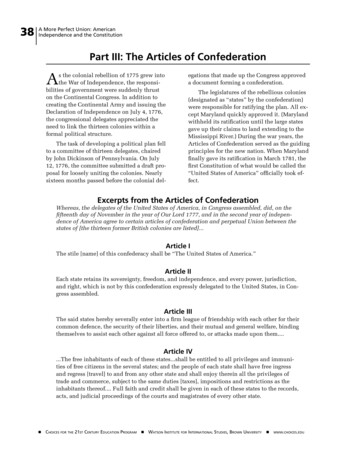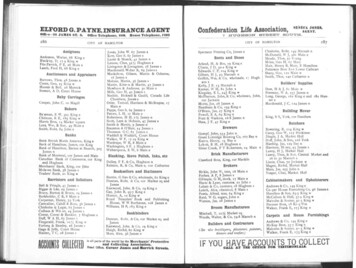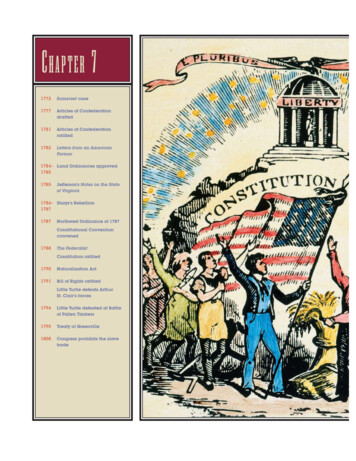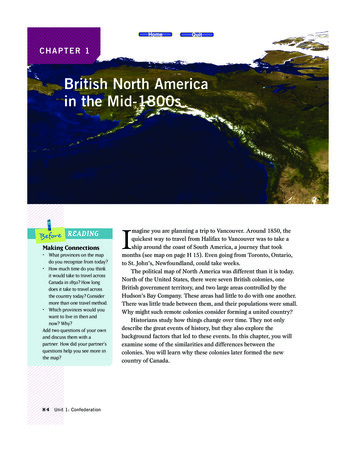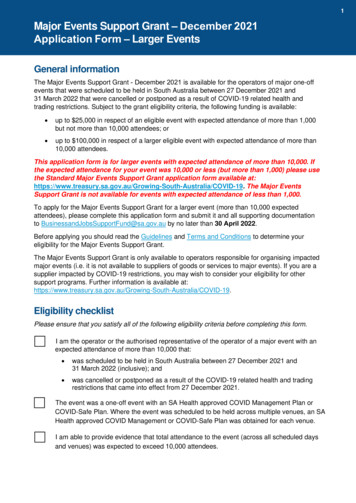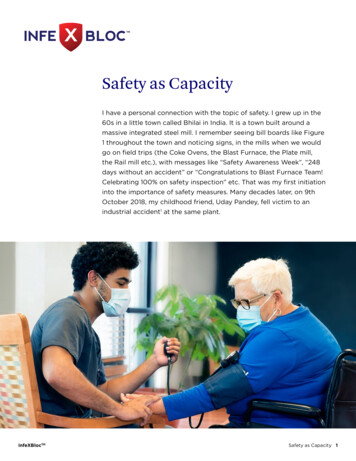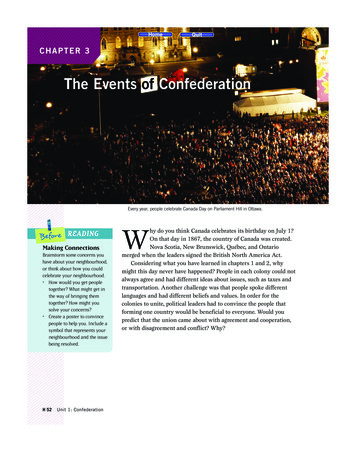
Transcription
ON8 history 03.qxd1/11/089:30 AMPage 52HomeQuitCHAPTER 3The Events of ConfederationEvery year, people celebrate Canada Day on Parliament Hill in Ottawa.Before READINGMaking ConnectionsBrainstorm some concerns youhave about your neighbourhood,or think about how you couldcelebrate your neighbourhood. How would you get peopletogether? What might get inthe way of bringing themtogether? How might yousolve your concerns? Create a poster to convincepeople to help you. Include asymbol that represents yourneighbourhood and the issuebeing resolved.H 52Unit 1: Confederationhy do you think Canada celebrates its birthday on July 1?On that day in 1867, the country of Canada was created.Nova Scotia, New Brunswick, Québec, and Ontariomerged when the leaders signed the British North America Act.Considering what you have learned in chapters 1 and 2, whymight this day never have happened? People in each colony could notalways agree and had different ideas about issues, such as taxes andtransportation. Another challenge was that people spoke differentlanguages and had different beliefs and values. In order for thecolonies to unite, political leaders had to convince the people thatforming one country would be beneficial to everyone. Would youpredict that the union came about with agreement and cooperation,or with disagreement and conflict? Why?W
ON8 history 03.qxd1/11/089:30 AMPage 53HomeQuitIn 1867, crowds gathered in Market Square, Kingston,to hear the proclamation announcing Confederation.Questions to Consideras You Read this ChapterLiteracyThinking AboutReading VisualsYou will explore these aspects of the Unit 1Big Idea: Why did some of the colonies putaside differences and create a new country—Canada?Visuals can include maps, art, cartoons,photographs, charts, and graphs. How did the map of Canada change?Visuals serve three purposes: to help youunderstand what you read (important); to addinformation that is not in the main text (important);to make the page look better (interesting). How were the responsibilities of governmentdivided between the federal and provincialgovernments? How is this organizationreflected in our present-day government?Use an organizer like this one to help you decidewhich visuals will help you understand theinformation and which might be good to revisit outof interest. How were the politicians able to join thecolonies When?Important?Explain.Interesting?Chapter 3: The Events of ConfederationH 53
ON8 history 03.qxd1/11/089:30 AMPage 54HomeQuitReal People Making History The Life of Sir John A. MacdonaldH 54Unit 1: Confederation
ON8 history 03.qxd1/11/089:30 AMPage 55HomeQuitReal People Making History The Life of Sir John A. MacdonaldChapter 3: The Events of ConfederationH 55
ON8 history 03.qxd1/11/089:30 AMPage 56HomeQuitCreating a NationDuring READINGCheckpointSkimming means you arereading quickly across the lines,looking for main ideas anddetails. Scanning means thatyou are zigzagging up and downthe page—most useful whenyou are looking for somethingspecific, like a date, or aboldfaced word or name. Scanfor visuals and subheadingsto add information to yourorganizer.WORDS MATTERconference a meeting fordiscussion of informationor ideasIn the early 1860s, the colonies of British North America were weakand isolated. Most colonists were keen to retain ties with Britain.They saw the United States as a threat, and were not sure how theycould defend themselves without Britain. Then, in 1864, eventsrelating to British North America’s future began to move quicklytoward unification. During the next three years, the structure ofmodern Canada began to emerge.The Charlottetown ConferenceIn September 1864, the Maritime colonies held a conference inCharlottetown, Prince Edward Island, to discuss the idea of aMaritime union. British Columbia and Newfoundland were notinvited. The Canadas were not Maritime colonies, but the leadingpoliticians from the Canadas managed to get an invitation.Representatives from P.E.I., New Brunswick, and Nova Scotia metwith representatives from the Canadas. The Canadians soonpersuaded the Maritimers to give up their original plans. Instead,John A. Macdonald and his colleagues got them to consider a unionwith the Canadas.The delegates at the conference agreed to support the idea ofjoining the Canadas and the Maritime colonies together. They alsodecided to meet again to discuss the plan further.The Québec ConferenceWomen were not directly involved in the Confederationconferences. In the evenings, the wives and daughters ofthe delegates joined the men for dinners and dances, suchas the one shown in this painting called Ball at Legislatureby Dusan Kadlec. How might this kind of socializing helpthe men agree on important issues?H 56Unit 1: ConfederationIn October 1864, representatives of the coloniesheld a second conference in Québec City. This timeNewfoundland attended as well, but BritishColumbia was too far away to be included. AtCharlottetown, they had agreed to the principle ofjoining the colonies, but they had not discussed thedetails of how this would be done. In Québec City,they met for three weeks and worked out the rulesfor sharing power in the new country.At the end of the conference, the delegatesvoted mostly in favour of the Québec Resolutions.These contained the details of how the newcountry would work. The following is a list of someof the features of Canada’s government:
ON8 history 03.qxd1/11/089:30 AMPage 57HomeQuit A federal constitution. This meant there would be a governmentfor the whole country, as well as for each province. Each level of government would be responsible for specific areas.For instance, Indian affairs were federal, whereas education wasprovincial, etc. In parliament, there would be a balance of representation bypopulation and equal representation. There would be a balance between elected and appointedrepresentatives.WORDS MATTERfederal relating to a system thathas a central government as wellas provincial or state governmentsIndian the historic term for FirstNations people. Though we nowuse the term First Nations,historic documents use “Indian;”the federal government still hasa Department of Indian Affairs,a name assigned at ConfederationJohn A. Macdonald was the main influence in the writing of theseresolutions. In the parliament of the Canadas, he won support for theplan, with 91 votes in favour and 33 opposed.Missing VoicesAs had been the case in the Canadas in the 1850s, politicians paid noattention to First Nations’ or black people’s concerns. The politicianswere men from Britain, Ireland, or France. They envisioned a Canadathat would look very much like those countries. Parliament, thecourts, the education system, and virtually everything else would bemodelled after British and European examples.Women were also ignored in the discussions, although they madeup about half the population. Remember from Chapter 2 that womendid not have any political representation. Although unfair, thesegroups were largely ignored in the discussions.CANADA MINUTEThe Great CoalitionA coalition is a group ofpeople, often politicalopponents, who agree to worktogether for a common goal.George Brown and John A.Macdonald, both Fathers ofConfederation, disliked oneanother, but, in 1864, Brownput aside his personalfeelings and offered to worktogether with Macdonald tofind a solution to thecolonies’ problems. Laterpoliticians have done thesame thing. During times ofwar, political opponents haveput aside their differences towork toward peace.The resolutions that the Fathers of Confederation adopted laid the foundations for theway Canadian government is run to this day.Chapter 3: The Events of ConfederationH 57
ON8 history 03.qxd1/11/089:30 AMPage 58HomeWORDS MATTERConfederation the union ofprovinces and territoriesforming CanadaQuitOpposition to the Québec ResolutionsOpinion was divided as to whether the Québec Resolutions were agood idea. Antoine-Aimé Dorion was the leader of Canada East’sRouge party. He believed that the proposals would lead to thedestruction of the French culture in what would become Québec.Dorion wanted a referendum—vote by the people—on the plan forunion, something Macdonald opposed. Dorion said:If confederation should be adopted without the people of thisprovince’s sanction, the entire country will sorely learn toregret it.A young lawyer named Wilfrid Laurier wrote:Antoine-Aimé DorionTwenty-five years ago the French nation was more vigorous,more united, strongly French Today it is without strength,[and] divided We must use all the influence we have left toobtain a free and separate government.In the Maritimes, there was even more opposition. Joseph Howewas a journalist and politician from Halifax. He helped Nova Scotiato win responsible government in 1848 and was premier of thatprovince from 1860 to 1863. While the Confederation conferenceswere being held, he was leader of the opposition to Nova Scotia’sjoining Confederation. He argued that the population was not beingfully consulted, and that Nova Scotia would be overwhelmed by thelarger provinces of Ontario and Québec. Howe also felt that theCanadas were too far away from Halifax for the union to be successful.He wrote in the Halifax Chronicle:Did anybody ever propose to unite Scotland with Poland orHungary? [They are] [i]nland countries [1300 km] off in thevery heart of Europe.Joseph HoweH 58Unit 1: ConfederationAttitudes toward Confederation depended on the local concerns ofeach colony. Governments and people were often in conflict about thewisdom of the proposal. The following organizer summarizes themain issues in each of the colonies.
ON8 history 03.qxd1/11/089:30 AMPage 59HomeQuitColonyGovernment LeaderAttitude Toward ConfederationThe CanadasJohn A. Macdonald andGeorge-Étienne CartierStrongly in favour. Saw it as a way to expand the domestic economy andprovide better defence against the U.S.Nova ScotiaCharles TupperIn favour, but in the Nova Scotia assembly his opponents defeated hisrequest for support of the Resolutions.New BrunswickLeonard TilleyIn favour. His party was defeated in the assembly in 1865 when it asked fora vote for Confederation. Tilley became premier again in 1866 and led NewBrunswick into Confederation even though there was widespread oppositionamong voters.Prince EdwardIslandJames PopeIn favour, if the new government would pay 800 000 to buy out theabsentee landlords. The Liberal opposition called this bribery, and defeatedPope in 1867. The new government refused to join Confederation.NewfoundlandFrederick CarterIn favour, but did not press the issue when civil disorder broke out overother issues in 1865. In 1869, he was defeated in an election by the AntiConfederation party. Newfoundlanders feared that their traditional way of lifewould be undermined in Confederation.The London ConferenceIn December 1866, representatives of Canada West, Canada East,New Brunswick, and Nova Scotia travelled to London, England.Newfoundland had dropped out of the discussions. The delegatestook part in a conference with British officials about the future of thecolonies. The colonial secretary, Lord Carnarvon, said of theconference’s workWe are laying the foundation of a great State. perhaps onewhich at a future day may even overshadow [Britain]. But,come what may, we shall rejoice that we have shown neitherindifference to their wishes nor jealousy of their aspirations.Agreement was reached easily and Canada became Britain’s first“self-governing Dominion.” Canada retained the monarchy, and itsmembership in the British Empire. Since the king or queen had noreal power in government, the monarchy remained a symbol andnothing more.Canada had control over its internal affairs, but Britain wouldhave control over foreign policy, meaning that Britain would negotiatewith other countries on Canada’s behalf. This situation continueduntil 1923. The conference delegates decided that Britain wouldcontinue to be responsible for any changes to the constitution ofCanada, but only at the request of the Canadian parliament. It wasnot until 1982 that this power was officially handed over to Canada.As you can see, Canada was not entirely independent in 1867;however, it made some important steps in that direction.Lord Carnarvon. Predict reasonswhy you think he said theCanadas “may even overshadow[Britain].” How did you reachyour conclusion?Chapter 3: The Events of ConfederationH 59
ON8 history 03.qxd1/11/089:31 AMPage 60HomeQuitConfederationOn July 1, 1867, a new country was born. The Dominion of Canadacontained four provinces: Ontario, Québec, New Brunswick, andNova Scotia. Queen Victoria had already chosen Ottawa as the capitalof the Canadas, and a new parliament building had opened there in1866. These now became the capital and parliament of the new nation.Canada, 1867GREENLANDARCTICOCEAN(DENMARK)ALASKADominion of Canada(U.S.A.)BNA coloniesNOTEH–I TOWERIEBR ITISLU M HBIAHBC controlledSTNESLabrador SeaWF OUHudsonBayNDLDDLANEUQONTA RION05001000 ritish controlledEANCORRTHNOVASCOTIAPRINCEEDWARDISLANDNEW BRUNSWICKOn that first “Canada Day,” there were celebrations in manylocations. Canons were fired, bands played, and fireworks exploded.The future looked bright. It would take much effort, however, to makeCanada a prosperous and united nation. The rest of Sir John A.Macdonald’s life, until he died in 1891, was dedicated to that goal.THINKING It Over1. Create and complete an organizer to show thedates, representatives attending, and key featuresof the Charlottetown Conference, the QuébecConference, and the London Conference. How doesknowing this information help you betterunderstand Canada’s political landscape today?k a cH 60Unit 1: Confederation2. Look at the quotations from Antoine-Aimé Dorion,Wilfrid Laurier, Joseph Howe, and Lord Carnarvon.Rewrite what each said in your own words. Whoseopinion comes closest to your own opinion aboutthe Confederation of Canada? Why? k t c
ON8 history 03.qxd1/11/089:31 AMPage 61HomeQuitThe British North America Act, 1867The act that made Canada independent was originally called theBritish North America Act (BNA Act). In 1982, it was renamed theConstitution Act, 1867. Historians still use the old name to describethe events of Confederation.Features of Canada’s New GovernmentThe BNA Act set the government up in the following manner:ItemDetailsA federal systemThere would be a parliament for the whole country,plus a legislature for each province.Bilingual featuresFrench and English would be the languages ofparliament, plus the legislature of Québec.A balance ofrepresentation bypopulation and equalrepresentationParliament would have two houses. There would berepresentation by population in the House ofCommons. In the Senate, each region (Ontario,Québec, and the Maritimes) would have the samenumber of seats.A balance betweenelected and appointedrepresentativesThe House of Commons would be elected by voters;the Senate would be appointed by the prime minister.During READINGCheckpointReview the questions on pageH 53. Look for answers as youskim and scan this chapter. Addthe information to yourorganizer. Continue adding newsections to the organizer, usingheadings in addition to pictures.WORDS MATTERact a piece of legislation passedby parliamentHouse of Commons the houseof parliament that is electedby voters and is based onrepresentation by populationSenate the house of parliamentthat is appointed by the primeminister and is based on equalrepresentation for various regionsHaving two levels of government could be difficult unless eachlevel understood which areas it was responsible for. Look at the charton page H 62. Sections 91, 92, and 93 of the BNA Act clearly laid outwhat the various responsibilities were.The provinces were given powers that were considered lessimportant in 1867. However, two of these—health care andeducation—have become very significant. Why do you thinkMacdonald did not want to give the provinces too much power?THINKING It Over1. Study the chart on page H 62. Which was the mostpowerful level of government in 1867? Today?Explain. k t2. Some provincial governments today say that theyshould have more power. They say that they arecloser to the people than the federal government is,and could therefore do a better job of dealing withmatters such as telecommunications or protectingthe environment. With a classmate, discuss whichlevel of government you think can best deal withsuch areas of responsibility, and why. t a cChapter 3: The Events of ConfederationH 61
ON8 history 03.qxd1/11/089:31 AMPage 62HomeINZOOMUD YCA SE STQuited betweenHow the powers were dividgovernmentsthe federal and provincialJohn A. Macdonald looked at the government of theUnited States and decided Canada’s governmentshould be different. In the U.S., the states havemany important powers. The federal government hasonly the leftover powers, and matters of foreignpolicy and national defence. This is why, forinstance, criminal law is different in every state inthe United States. Some states practise capitalpunishment for first-degree murder, while othershave abolished executions altogether.Macdonald believed that the Americans had notarranged things well. He thought that givingindividual states too much power makes a nationless united. He believed that this had, in part,caused the American Civil War (1861–1865). Somestates believed that they should have the right topractise slavery and refused to give up this right.This crisis nearly tore the country apart.If the federal government had all the importantpowers, Macdonald believed, Canada could avoidhaving provinces leave the nation.Not everything has gone to plan. Some powersthat were considered unimportant and given to theprovinces—such as health care and education—havesince become important. Nova Scotia elected aseparatist government in 1867. Québec heldreferendums on separation in 1980 and 1995. Byand large, however, the division of powers hashelped to keep Canada together.SectionClauseItemExampleSection 91(federal)3taxationincome tax, taxes on corporations, import duties7national defencethe military24Aboriginal affairsIndian reserves and support (like health care and education)27criminal lawmaking murder, smuggling, and theft illegal29any item not specifically madea provincial power. (These arecalled residual powers.)items that had not been invented in 1867, such as licensing oftelevision stations or telecommunications networks2limited powers of taxationincome tax, taxes on corporations, provincial sales tax7health carehospitals and licensing of doctors8local governmentthe City of Toronto, Essex County (Windsor area)10roads and bridgesmaintaining highways that connect communities (whereas roadswithin communities are the responsibility of municipal governments)1educationschool boards, colleges, and universitiesSection 92(provincial)Section 93(provincial)THINKING It Over1. For one week, look through local and nationalnewspapers and magazines. Listen to televisionand radio broadcasts. Find issues connected togovernment, such as health care, Aboriginal issues,revenues from oil and natural gas. Keep a list ofthe topics, note which government is responsible,and whether or not there is a conflict between thetwo levels of government. Share your findings in asmall group. tH 62Unit 1: Confederation2. Do some research to find out about a recentdispute between the federal government and theprovinces about one of the following areas:Aboriginal people, health care, the environment,trade, or telecommunications. Explain (a) thefederal position in the disagreement, (b) theprovincial position, and (c) which position you feelmakes more sense, and why. t a c
ON8 history 03.qxd1/11/089:31 AMPage 63HomeQuitHISTORICAL THINKING SKILLAnalyzing Cause and ConsequenceIn this chapter, you have been reading about Canada becoming a nation in1867. When historians look at an “event” like Confederation they often askwhy? and so what? questions. They want to know the causes of the event aswell as the consequences of it.Step 1Analyze cause and consequenceThe first stage in analyzing cause and consequence involves asking goodquestions about the event. Some of these questions for Confederationmight be: Why did the colonies choose to come together at that particular time? Why did Confederation take the shape it did? What have been the long term results of the decisions made in the 1860s?Step 2Remember that answers can be complexIt is important to remember that answers to these kinds of questions areusually not simple, but quite complex. For example, causes usually includecircumstances of the time as well as the actions of particular people. Mostimportant events also have many consequences and some of these might bepositive and others negative.APPLY ItUsing the material in this chapter andinformation from elsewhere, complete thefollowing charts. Remember when thinkingabout the people that both supporters andopponents of Confederation helped to shape it.Causes of ConfederationCauseCircumstances of The TimeThe United States was strong and unitedPeopleAntoine-Aimé DorionImpact on ConfederationCanadian colonies worried about invasion and so began toconsider unifying.He and others were worried about the loss of provincialrights. He pushed the politicians to include strongprovincial governments in the BNA Act.Consequences of ConfederationPositiveNegativeCanada became a country that balancesnational and provincial concerns.Aboriginal voices were left out. Aboriginal Peoples have hadto fight for recognition and rights since 1867.Chapter 3: The Events of ConfederationH 63
ON8 history 03.qxd1/11/089:31 AMPage 64HomeQuitHow Did the Map of Canada Change?In 1867, Canada consisted of only four provinces (see map on pageH 60). However, the new constitution allowed for the possibility thatother provinces might join. On these maps, orange identifiesCanadian provinces. The map of Canada underwent many changesbetween 1870 and 1871.During READINGCheckpointLook again at the maps. Whatpurposes do these visualshave? How do the maps helpyou to understand how Canadadeveloped over time?Canada, .A.)Dominion of Canada, 1867BNA coloniesLabrador SeaTHEBNA colonies before 1871;Dominion of Canada after1871Territory of the Dominionof Canada, 1870NENORTH–WESTBRCO ITISHLUMBIAOUNDLAT E R R I TO R I E SÉBDominion of Canada, 1870ONNTA RIONDECPRINCEEDWARDISLANDQUMANITOBAPACIFIC OCEANWFNOVASCOTIANEW BRUNSWICK0500WORDU.S.A.1000 kmS MATTERhypothesis an educated guess ortheory that has not been provenATLANTIC OCEANIf you look at a modern atlas, you will see that the map of Canadahas changed again. In fact, the map has changed several timesbetween 1871 and now. In later chapters, you will see how thesechanges occurred.THINKING It Over1. Compare this map to the map of Canada in 1867on page H 60. Identify the changes you seebetween the two maps. k aH 64Unit 1: Confederation2. Why do you think these changes occurred? Makea hypothesis about each change. Record yourhypotheses. You will return to them in laterchapters. t
ON8 history 03.qxd1/17/0812:16 PMPage 65HomeQuitPUTTING IT ALL TOGETHERYou have seen how the leaders of the coloniesmet and created a plan to join the colonies intoan independent nation, Canada. You haveexamined the details of the plan that wasdeveloped by the politicians (the BNA Act). Youhave also studied the way in which the map ofCanada changed in the years up to 1871.After READINGReading VisualsReview your organizers.How did the visuals and words in each sectionsupport each other? Were there any visuals youcould have ignored and come back to later?With a partner, discuss what would help you knowwhen to focus on visuals and when to come backto them n?Important?Explain.Interesting?THINKING It Through1. You have seen how the map of Canada changedbetween 1867 and 1871. Now you are going towork with the changes that took place in 1873,1898, and 1905. Using maps that your teacherwill give you, examine how Canada grew duringthose years.a) Create your own copies of these maps. Be sure toshow the boundaries of each of the provinces asthey appear at each date. On each map, be sure toinclude all the map conventions you learned aboutin Grade 7 geography (title, legend, compass rose,and scale). In addition, on each map, indicatethe date that each province entered Confederation.k ab) In a paragraph for each map, (i) identify thechanges that have taken place in Canada since theprevious map (between 1871 and 1873, 1873 and1898, and 1898 and 1905), and (ii) predict howeach set of changes would have helped to makeCanada a stronger nation. t c2. As an alternative, you could work in a group toorganize a mock Confederation conference. Assignmembers of the group to represent the variousleaders, each preparing a persuasive speechpresenting that leader’s point of view. Draft a set of sixresolutions about how the proposed new countryshould be run. At the end of the conference, take avote. k t c3. Create a Word Power game. Choose five of the keyterms from this chapter and write a multiple choicedefinition for each one. Include the correct definitionusing your own words and two incorrect ones. Tradegames with a classmate and see how well you do atidentifying the correct definitions. k t cChapter 3: The Events of ConfederationH 65
ON8 history 03.qxd1/11/089:31 AMPage 66HomeQuitBack to the Big IdeaWhy did some of the colonies put asidedifferences and create a new country—Canada?Throughout this unit, you have looked at the main features of the colonies of British North Americain the early 1860s examined the various factors that caused them to work together tosolve their common problems followed the main events that took place as the political leadersworked to unite the colonies identified the various reasons the colonies thought they would bebetter off as an independent nationUse the graphic organizers you completed while reading the chapter toreview what you have learned. Create a graphic organizer to answer thequestion, Why did some of the colonies put aside differences and createa new country—Canada?British North AmericancoloniesBritish controlled (butnot formal colonies)Hudson’s Bay NEWCALEDONIARussian controlledPERT’SLANH 665001000 kmEANAU.S.A.Unit 1: ConfederationA DPRINCEEDWARDNOVAISLANDSCOTIANEW BRUNSWICK
ON8 history 03.qxd1/11/089:31 AMPage 67HomeQuitShow That You KnowReview the graphic organizer you created to answer the Big Ideaquestion on the previous page. What do you think was the mostimportant reason that the colonies decided to unite into a singlenation? This will be the subject of your unit culminating activity.Step 1 Ask questionsCreate two questions for each inquiry word (who? what? when? where?why? how?) about your topic.Step 2 Identify primary and secondary sourcesMake a short list of primary sources and secondary sources that couldhelp you find information about your topic. Primary sources couldinclude journals, letters, statistics, period documents, and maps.Secondary sources could include modern maps, illustrations, printmaterials, videos, CD-ROMS, and Internet sites. Create a bibliographycontaining at least two primary sources and two secondary sources thatyou will use.Tip: Review the material aboutasking questions. See pageS 8.Tip: Find sources in a librarycatalogue or on the Internet.See page S 2.Tip: Include quotations fromprimary materials.Step 3 Summarize the information about your topicStudy your sources, making notes as you do so. Create short writtensummaries about different aspects of your topic.Step 4 Arrange your material in an interesting and creativemannerCreate your final copy, making sure that it contains all the elementslisted in the various steps.Step 5 Present your findingsPresent your findings to a small group of students or to the whole class.Make sure that you have all of the following Create any of the followingvisual items that apply:timeline, graph, map,model. See pages S 12–S 13.Tip: Create a written introductionand conclusion. Include your bibliography.Tip: Practise presenting yourmaterial to make sure it fitstogether properly. oral material visual material written materialUnit 1: ConfederationH 67
destruction of the French culture in what would become Québec. Dorion wanted a referendum—vote by the people—on the plan for union, something Macdonald opposed. Dorion said: A young lawyer named Wilfrid Laurier wrote: In the Maritimes, there was even more opposition. Joseph Howe was a journalist and politician from Halifax. He helped Nova .



